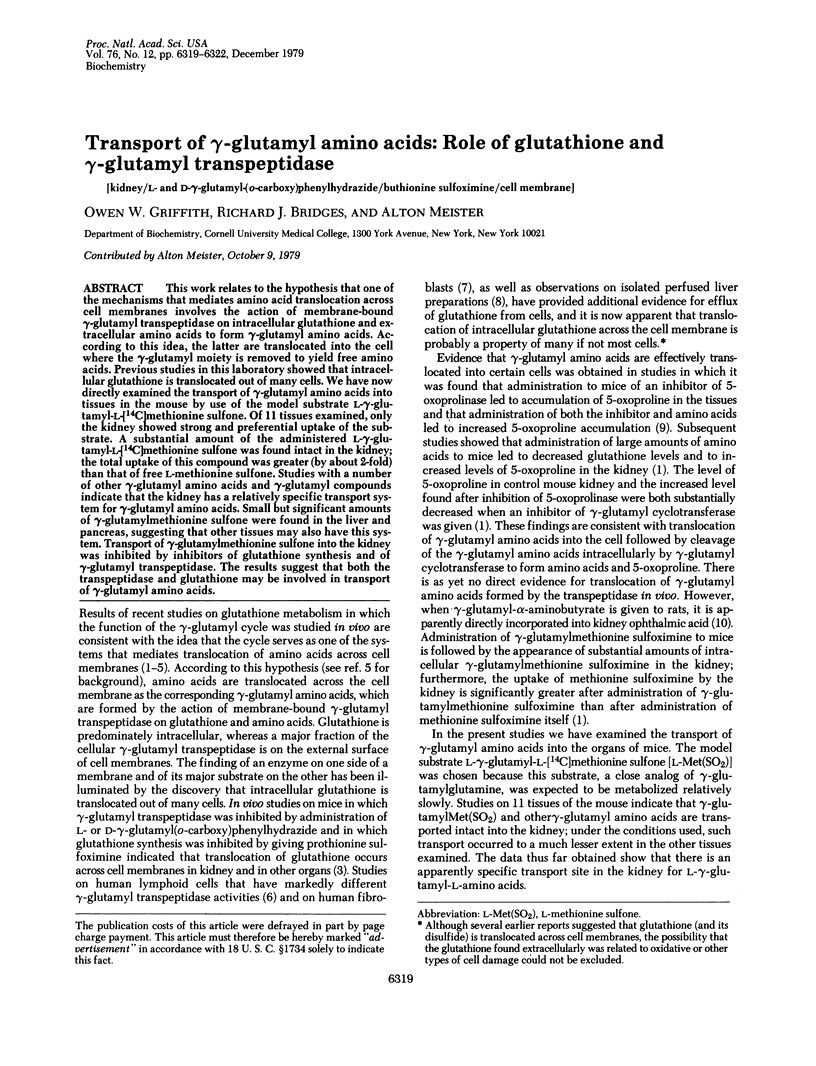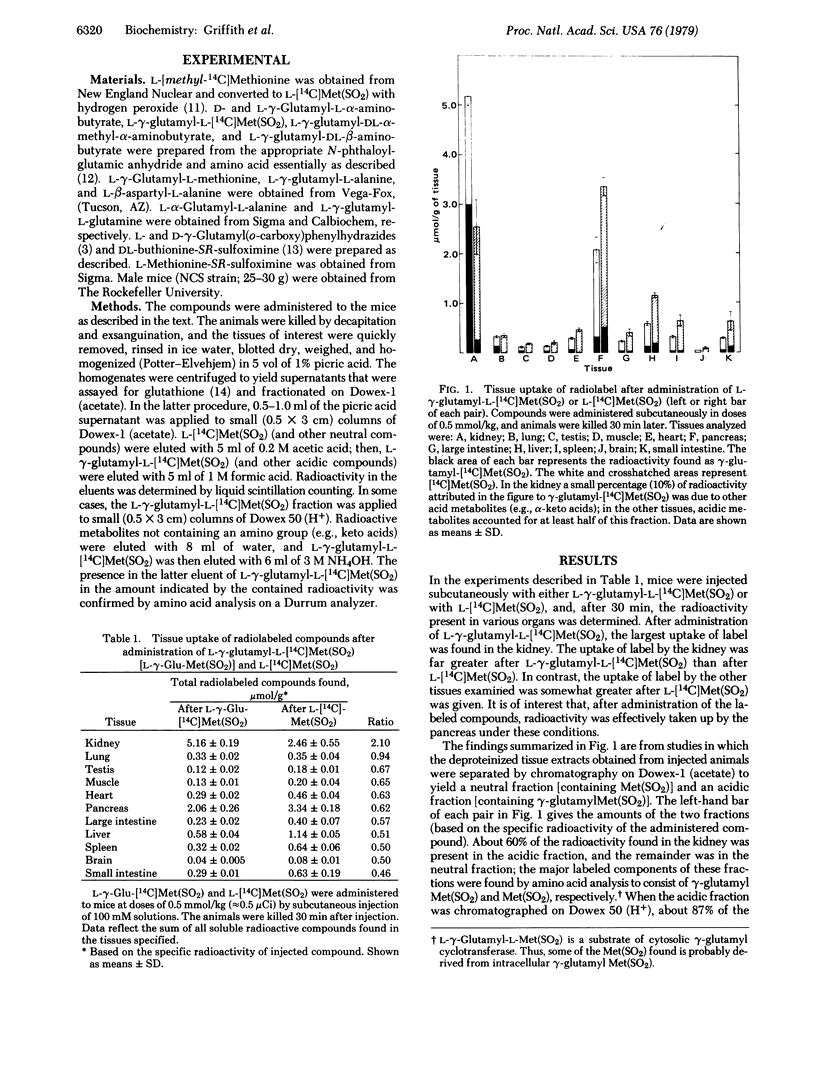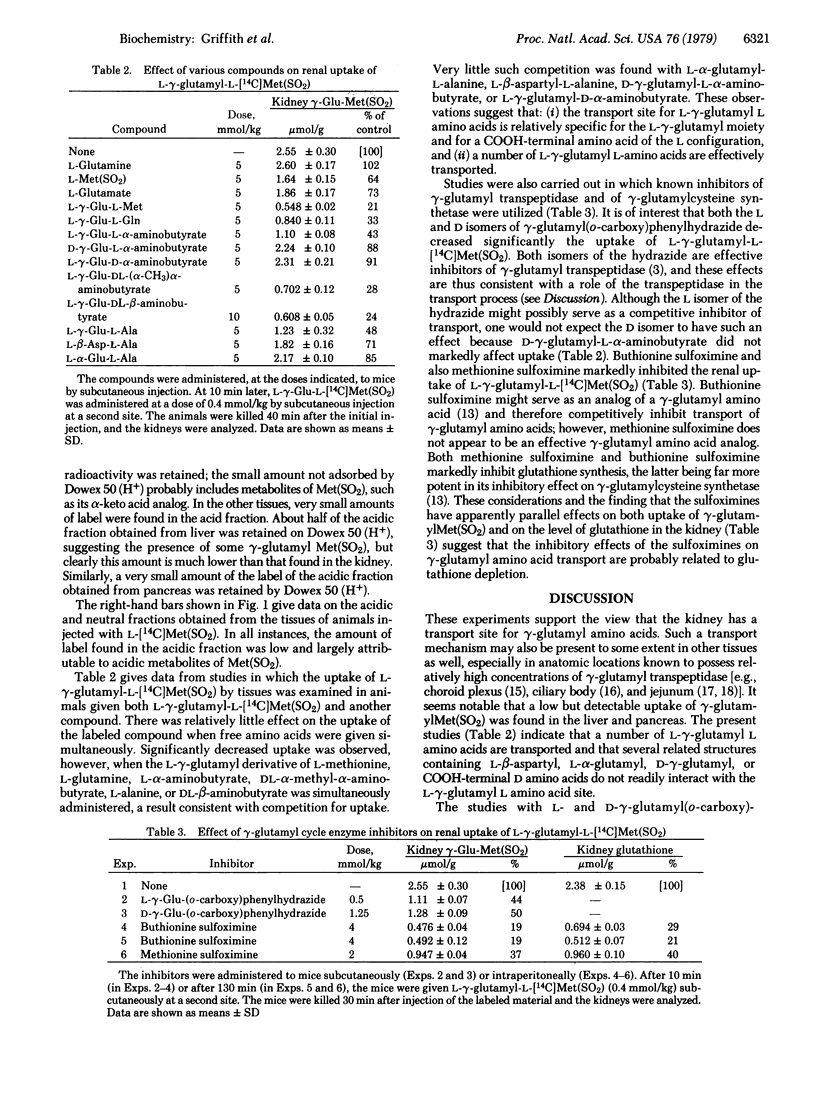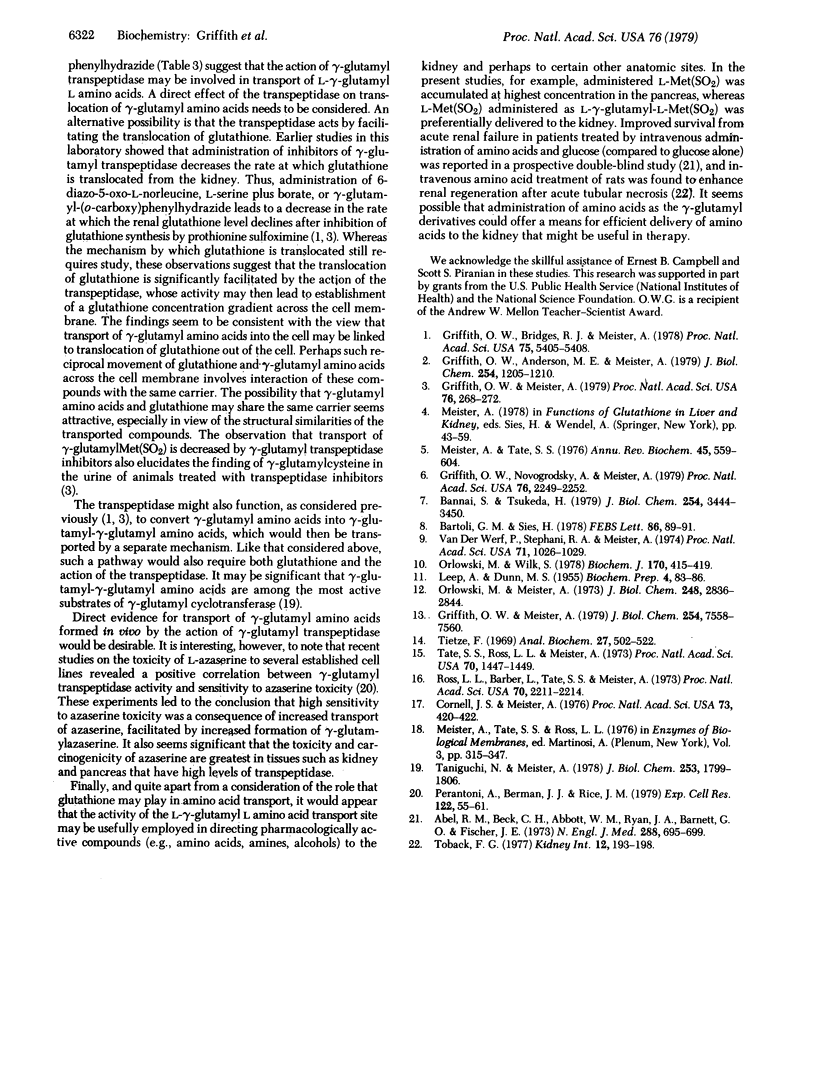Abstract
This work relates to the hypothesis that one of the mechanisms that mediates amino acid translocation across cell membranes involves the action of membrane-bound gamma-glutamyl transpeptidase on intracellular glutathione and extracellular amino acids to form gamma-glutamyl amino acids. According to this idea, the latter are translocated into the cell where the gamma-glutamyl moiety is removed to yield free amino acids. Previous studies in this laboratory showed that intracellular glutathione is translocated out of many cells. We have now directly examined the transport of gamma-glutamyl amino acids into tissues in the mouse by use of the model substrate L-gamma-glutamyl-L-[14C]methionine sulfone. Of 11 tissues examined, only the kidney showed strong and preferential uptake of the substrate. A substantial amount of the administered L-gamma-glutamyl-L-[14C]methionine sulfone was found intact in the kidney; the total uptake of this compound was greater (by about 2-fold) than that of free L-methionine sulfone. Studies with a number of other gamma-glutamyl amino acids and gamma-glutamyl compounds indicate that the kidney has a relatively specific transport system for gamma-glutamyl amino acids. Small but significant amounts of gamma-glutamylmethionine sulfone were found in the liver and pancreas, suggesting that other tissues may also have this system. Transport of gamma-glutamylmethionine sulfone into the kidney was inhibited by inhibitors of glutathione synthesis and of gamma-glutamyl transpeptidase. The results suggest that both the transpeptidase and glutathione may be involved in transport of gamma-glutamyl amino acids.
Full text
PDF



Selected References
These references are in PubMed. This may not be the complete list of references from this article.
- Abel R. M., Beck C. H., Jr, Abbott W. M., Ryan J. A., Jr, Barnett G. O., Fischer J. E. Improved survival from acute renal failure after treatment with intravenous essential L-amino acids and glucose. Results of a prospective, double-blind study. N Engl J Med. 1973 Apr 5;288(14):695–699. doi: 10.1056/NEJM197304052881401. [DOI] [PubMed] [Google Scholar]
- Bannai S., Tsukeda H. The export of glutathione from human diploid cells in culture. J Biol Chem. 1979 May 10;254(9):3444–3450. [PubMed] [Google Scholar]
- Bartoli G. M., Sies H. Reduced and oxidized glutathione efflux from liver. FEBS Lett. 1978 Feb 1;86(1):89–91. doi: 10.1016/0014-5793(78)80105-7. [DOI] [PubMed] [Google Scholar]
- Cornell J. S., Meister A. Glutathione and gamma-glutamyl cycle enzymes in crypt and villus tip cells of rat jejunal mucosa. Proc Natl Acad Sci U S A. 1976 Feb;73(2):420–422. doi: 10.1073/pnas.73.2.420. [DOI] [PMC free article] [PubMed] [Google Scholar]
- Griffith O. W., Anderson M. E., Meister A. Inhibition of glutathione biosynthesis by prothionine sulfoximine (S-n-propyl homocysteine sulfoximine), a selective inhibitor of gamma-glutamylcysteine synthetase. J Biol Chem. 1979 Feb 25;254(4):1205–1210. [PubMed] [Google Scholar]
- Griffith O. W., Bridges R. J., Meister A. Evidence that the gamma-glutamyl cycle functions in vivo using intracellular glutathione: effects of amino acids and selective inhibition of enzymes. Proc Natl Acad Sci U S A. 1978 Nov;75(11):5405–5408. doi: 10.1073/pnas.75.11.5405. [DOI] [PMC free article] [PubMed] [Google Scholar]
- Griffith O. W., Meister A. Potent and specific inhibition of glutathione synthesis by buthionine sulfoximine (S-n-butyl homocysteine sulfoximine). J Biol Chem. 1979 Aug 25;254(16):7558–7560. [PubMed] [Google Scholar]
- Griffith O. W., Meister A. Translocation of intracellular glutathione to membrane-bound gamma-glutamyl transpeptidase as a discrete step in the gamma-glutamyl cycle: glutathionuria after inhibition of transpeptidase. Proc Natl Acad Sci U S A. 1979 Jan;76(1):268–272. doi: 10.1073/pnas.76.1.268. [DOI] [PMC free article] [PubMed] [Google Scholar]
- Griffith O. W., Novogrodsky A., Meister A. Translocation of glutathione from lymphoid cells that have markedly different gamma-glutamyl transpeptidase activities. Proc Natl Acad Sci U S A. 1979 May;76(5):2249–2252. doi: 10.1073/pnas.76.5.2249. [DOI] [PMC free article] [PubMed] [Google Scholar]
- Meister A., Tate S. S. Glutathione and related gamma-glutamyl compounds: biosynthesis and utilization. Annu Rev Biochem. 1976;45:559–604. doi: 10.1146/annurev.bi.45.070176.003015. [DOI] [PubMed] [Google Scholar]
- Orlowski M., Meister A. -Glutamyl cyclotransferase. Distribution, isozymic forms, and specificity. J Biol Chem. 1973 Apr 25;248(8):2836–2844. [PubMed] [Google Scholar]
- Orlowski M., Wilk S. Synthesis of ophthalmic acid in liver and kidney in vivo. Biochem J. 1978 Feb 15;170(2):415–419. doi: 10.1042/bj1700415. [DOI] [PMC free article] [PubMed] [Google Scholar]
- Perantoni A., Berman J. J., Rice J. M. L-azaserine toxicity in established cell lines: correlation with gamma-glutamyl transpeptidase activity. Exp Cell Res. 1979 Aug;122(1):55–61. doi: 10.1016/0014-4827(79)90560-3. [DOI] [PubMed] [Google Scholar]
- Ross L. L., Barber L., Tate S. S., Meister A. Enzymes of the gamma-glutamyl cycle in the ciliary body and lens. Proc Natl Acad Sci U S A. 1973 Aug;70(8):2211–2214. doi: 10.1073/pnas.70.8.2211. [DOI] [PMC free article] [PubMed] [Google Scholar]
- Taniguchi N., Meister A. gamma-Glutamyl cyclotransferase from rat kidney. Sulfhydryl groups and isolation of a stable form of the enzyme. J Biol Chem. 1978 Mar 25;253(6):1799–1806. [PubMed] [Google Scholar]
- Tate S. S., Ross L. L., Meister A. The -glutamyl cycle in the choroid plexus: its possible function in amino acid transport. Proc Natl Acad Sci U S A. 1973 May;70(5):1447–1449. doi: 10.1073/pnas.70.5.1447. [DOI] [PMC free article] [PubMed] [Google Scholar]
- Tietze F. Enzymic method for quantitative determination of nanogram amounts of total and oxidized glutathione: applications to mammalian blood and other tissues. Anal Biochem. 1969 Mar;27(3):502–522. doi: 10.1016/0003-2697(69)90064-5. [DOI] [PubMed] [Google Scholar]
- Toback F. G. Amino acid enhancement of renal regeneration after acute tubular necrosis. Kidney Int. 1977 Sep;12(3):193–198. doi: 10.1038/ki.1977.100. [DOI] [PubMed] [Google Scholar]
- Van Der Werf P., Stephani R. A., Meister A. Accumulation of 5-oxoproline in mouse tissues after inhibition of 5-oxoprolinase and administration of amino acids: evidence for function of the gamma-glutamyl cycle. Proc Natl Acad Sci U S A. 1974 Apr;71(4):1026–1029. doi: 10.1073/pnas.71.4.1026. [DOI] [PMC free article] [PubMed] [Google Scholar]


